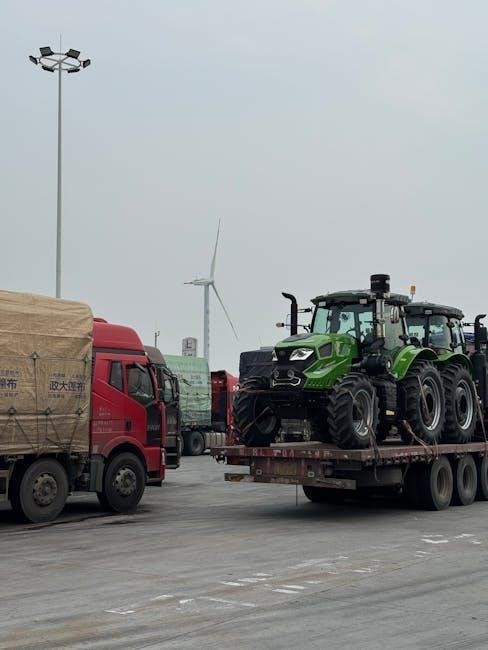Weld Truck Flatbed Drawings PDF: A Comprehensive Guide
Transforming your truck into a versatile workhorse starts with the right blueprints. Free DIY weld truck flatbed drawings in PDF format simplify the build process. These resources provide clear dimensions‚ material lists‚ and step-by-step guidance for a precise and tailored flatbed.
Building a flatbed for your truck offers a practical and cost-effective solution for customizing your vehicle for hauling purposes. It’s a challenging yet rewarding project that allows you to tailor the bed to your specific needs‚ whether for work or recreational use. A flatbed truck is often preferred over a standard pickup because it provides easier access to equipment and allows for more customized storage solutions.
DIY weld truck flatbeds involve measuring‚ cutting‚ and welding materials to fit your truck’s dimensions. The availability of free DIY weld truck flatbed drawings in PDF format simplifies this process‚ ensuring precision and safety. These drawings typically provide clear dimensions and material lists‚ making the build more manageable. With careful planning‚ the right materials‚ and attention to detail‚ you can transform your truck into a versatile workhorse.
These beds can be welded‚ bolted‚ or screwed onto the frame‚ offering flexibility in the construction process. The ability to customize storage solutions further enhances the utility of a DIY flatbed‚ making it an ideal choice for those who need a specialized hauling solution.
Benefits of Building Your Own Flatbed
Opting to construct your flatbed provides numerous advantages‚ primarily revolving around customization and cost-effectiveness. Unlike purchasing a pre-made flatbed‚ building your own allows for tailoring every aspect to your specific requirements. This includes dimensions‚ storage solutions‚ and material choices‚ ensuring the final product perfectly aligns with your intended use‚ whether for work or leisure.
Cost savings are another significant benefit. By sourcing materials and utilizing free DIY weld truck flatbed drawings in PDF format‚ you can significantly reduce expenses compared to buying a ready-made flatbed. This approach allows you to control the budget and prioritize quality in specific areas‚ such as welding or decking materials.
Furthermore‚ building your own flatbed provides an opportunity to enhance your welding and fabrication skills. The project involves various techniques‚ from frame construction to installing custom features‚ offering a hands-on learning experience. The satisfaction of creating a durable and functional flatbed tailored to your needs adds to the overall value of the project. The end result is a customized‚ cost-effective‚ and personally fulfilling upgrade to your truck.

Essential Tools and Materials
Constructing a weld truck flatbed requires a specific set of tools and materials to ensure structural integrity and functionality. Essential tools include a welding machine (MIG‚ TIG‚ or stick)‚ an angle grinder with cutting and grinding discs‚ a measuring tape‚ a level‚ a square‚ and various hand tools like wrenches‚ sockets‚ and pliers. Clamps are crucial for holding pieces in place during welding‚ and a welding helmet and gloves are necessary for safety.
Material selection is equally important. Steel is a common choice for the frame‚ typically square tubing or C-channel for its strength and weldability. Sheet metal or diamond plate can be used for the decking‚ providing a durable and slip-resistant surface. Fasteners‚ such as bolts and screws‚ are needed for securing components.
Additionally‚ consider consumables like welding wire‚ grinding wheels‚ and cutting discs. For finishing‚ you’ll need primer‚ paint‚ and possibly rust-resistant coatings. Custom storage solutions may require additional materials like hinges‚ latches‚ and toolbox components. Sourcing quality materials and having the right tools will contribute to a successful and long-lasting flatbed build. Always prioritize safety equipment when working with power tools and welding.
Determining Truck Bed Dimensions
Accurately determining truck bed dimensions is paramount for a successful flatbed build. Start by measuring the length and width of the truck’s frame‚ considering the desired overhang or flush fit. Measure from the back of the cab to the rear of the frame to establish the maximum length‚ ensuring adequate clearance for turning and avoiding interference with any rear-mounted components.
The width should be measured between the outer edges of the frame rails‚ allowing for any necessary side clearance. Also‚ consider the height of the flatbed relative to the truck’s frame. This measurement will affect the overall appearance and functionality‚ especially if you plan to integrate storage boxes or other features.
Take into account the location of existing mounting points on the truck frame‚ as these will be used to secure the flatbed. Note the distance between these points to ensure proper alignment. Double-check all measurements and create a detailed sketch or diagram. Accurate dimensions are critical for a secure‚ well-fitted flatbed that meets your specific needs and complies with safety regulations. Precise measurements will prevent costly errors during the construction phase.

Free PDF Drawing Resources
Numerous online resources offer free PDF drawings for DIY weld truck flatbeds‚ serving as invaluable guides for both novice and experienced welders. These drawings typically include detailed dimensions‚ material lists‚ and step-by-step instructions‚ streamlining the construction process. Many websites dedicated to welding‚ metal fabrication‚ and DIY projects host downloadable PDF plans for various flatbed designs‚ catering to different truck models and intended uses.
Some manufacturers of welding equipment and truck accessories also provide free drawings as a way to promote their products and support the DIY community. Online forums and communities dedicated to truck modifications often feature shared plans and user-generated designs‚ offering a wealth of practical knowledge and inspiration.
When utilizing free PDF drawing resources‚ carefully review the plans to ensure they match your specific truck model and project requirements. Pay close attention to the dimensions‚ material specifications‚ and welding techniques outlined in the drawings. It’s also advisable to consult with experienced welders or fabricators to verify the accuracy and suitability of the plans before commencing construction. Utilizing these free resources effectively can save time and money while helping to create a custom flatbed that perfectly meets your needs.
Frame Construction: Welding Techniques
Constructing a robust frame is paramount for any DIY weld truck flatbed‚ and proper welding techniques are crucial for ensuring structural integrity. Typically‚ the frame is built from steel tubing or C-channel‚ meticulously cut and welded together to form a rectangular base that matches the truck’s dimensions. Precise measurements are essential to guarantee a snug fit and prevent any instability.
Welding should be performed by experienced individuals with a strong understanding of metal properties and welding procedures. MIG (Metal Inert Gas) welding is a popular choice for its speed and ease of use‚ while TIG (Tungsten Inert Gas) welding offers greater precision and control‚ especially for thinner materials. Before welding‚ thoroughly clean all surfaces to remove any rust‚ grease‚ or contaminants that could compromise the weld strength.
Use appropriate welding parameters‚ such as voltage and amperage‚ to achieve proper penetration and fusion. Employ techniques like stitch welding or continuous welding to distribute heat evenly and minimize warping. After welding‚ allow the frame to cool gradually to prevent stress cracking. Inspect all welds carefully for any defects‚ such as porosity or incomplete fusion‚ and repair them as needed. Reinforcing critical joints with gussets or additional weld beads can further enhance the frame’s strength and durability.
Decking Options and Installation
Selecting the right decking material is vital for creating a functional and durable flatbed surface. Common options include wood‚ steel‚ and aluminum‚ each offering unique advantages and disadvantages. Wood decking‚ such as treated lumber or hardwood‚ provides a classic look‚ good traction‚ and is relatively inexpensive. However‚ it’s susceptible to rot‚ wear‚ and requires regular maintenance.
Steel decking‚ typically diamond plate or smooth steel sheets‚ offers exceptional strength‚ durability‚ and resistance to wear and tear. It’s ideal for heavy-duty applications but can be heavier and more prone to rust if not properly treated. Aluminum decking is lightweight‚ corrosion-resistant‚ and provides a sleek appearance. However‚ it’s generally more expensive than steel or wood and may not be as strong.
Installation involves securing the decking material to the frame using various methods‚ such as welding‚ bolting‚ or screwing. Welding is suitable for steel decking‚ providing a strong and permanent connection. Bolting and screwing are preferred for wood and aluminum decking‚ allowing for easier removal and replacement if needed. Ensure proper spacing and alignment during installation to prevent gaps or uneven surfaces. Consider adding a protective coating or finish to the decking to enhance its durability and appearance.
Custom Storage Solutions and Toolboxes
A key advantage of building your own flatbed is the ability to integrate custom storage solutions tailored to your specific needs; Toolboxes‚ side boxes‚ and under-bed compartments can be strategically placed to maximize space and accessibility. Consider the types of tools and equipment you’ll be carrying and design storage solutions accordingly.
Weatherproof toolboxes are essential for protecting your valuable tools from the elements. Look for boxes made from durable materials like steel or aluminum with secure locking mechanisms. Side boxes can be integrated into the flatbed’s skirt‚ providing convenient access to frequently used items. Under-bed compartments are ideal for storing larger items like welding leads‚ hoses‚ and spare parts.

When designing your storage solutions‚ consider factors like weight distribution‚ ease of access‚ and security. Ensure that the storage compartments are properly secured to the flatbed frame to prevent movement or damage. Customizing your flatbed with thoughtfully designed storage solutions will not only enhance its functionality but also improve your overall work efficiency and organization. Explore options like slide-out trays‚ adjustable shelves‚ and custom dividers to further optimize your storage space.

Welding Bed Features for Mobile Welders
For mobile welders‚ a flatbed truck is more than just a platform; it’s a mobile workshop. Designing specific features catering to welding needs is essential. These features enhance efficiency‚ organization‚ and safety while on the job site. A dedicated welding machine platform is a must-have‚ providing a stable and secure base for your welder.
Integrated storage for compressed gas cylinders and welding leads is crucial. Consider incorporating compartments with secure straps or chains to keep cylinders in place during transit. Easy access to welder controls is also important‚ possibly through strategically placed access panels or a remote control setup.
Furthermore‚ think about adding a built-in workbench area with a sturdy surface for welding and fabrication tasks. A headache rack can protect the cab from shifting loads and can also serve as a mounting point for lights and other accessories. Custom configurations that maximize bed space and provide ample room to work are also beneficial. By incorporating these features‚ you can transform your flatbed into a highly functional and efficient mobile welding unit. The streamlined design maximizes bed space so there’s plenty of room to work.
Wiring and Electrical Considerations
Integrating wiring and electrical components into your weld truck flatbed requires careful planning and execution. Proper wiring is essential for powering lights‚ auxiliary equipment‚ and any custom electrical features you incorporate. Begin by planning your electrical layout‚ determining the number and location of lights‚ outlets‚ and switches.
Use high-quality‚ properly insulated wiring that is rated for automotive use. Protect wiring runs with conduit or wire loom to prevent damage from abrasion‚ heat‚ and the elements. Securely attach wiring to the frame using clamps or zip ties‚ ensuring it is out of the way of moving parts and sharp edges.
Consider adding a dedicated electrical panel or fuse box to easily manage and protect your electrical circuits. Ensure all connections are properly grounded to prevent electrical shocks and ensure reliable operation. If you are not comfortable working with electrical systems‚ consult with a qualified electrician to ensure the wiring is done safely and correctly. Remember to check local regulations regarding vehicle wiring and electrical modifications. Integrating work lights for increased visibility is a great safety feature.
Priming‚ Painting‚ and Finishing
Priming‚ painting‚ and finishing are essential steps in completing your DIY weld truck flatbed‚ enhancing both its appearance and longevity. Start by thoroughly cleaning the metal surfaces‚ removing any rust‚ grease‚ or debris. Sanding the metal creates a better surface for the primer to adhere to‚ ensuring a smooth and durable finish.
Apply a high-quality metal primer to protect the steel from corrosion. Choose a primer specifically designed for automotive applications‚ as these offer superior rust prevention and adhesion. Allow the primer to dry completely before moving on to the painting stage. Select a durable‚ weather-resistant paint that can withstand the harsh conditions of daily use.
Apply multiple thin coats of paint‚ allowing each coat to dry before applying the next. This prevents runs and ensures even coverage. Consider using a clear coat for added protection and a glossy finish. If using wood decking‚ apply a sealant or stain to protect the wood from moisture and UV damage. Pay attention to details like smoothing welds and sanding rough edges for a professional look. Regular maintenance‚ such as washing and waxing‚ will help keep your flatbed looking its best for years to come.
Securing the Flatbed to the Truck Frame
Properly securing the flatbed to the truck frame is crucial for safety and stability. Begin by carefully aligning the flatbed with the truck’s frame rails. Use existing bolt holes whenever possible to avoid drilling into the frame‚ which can compromise its structural integrity. If drilling is necessary‚ consult your truck’s service manual for recommended locations and procedures.
Use high-strength bolts‚ nuts‚ and washers to attach the flatbed to the frame. Ensure that all fasteners are properly torqued according to the manufacturer’s specifications. Consider adding additional support brackets or plates to reinforce the connection‚ especially if you plan to carry heavy loads. Welding the flatbed to the frame can provide an even stronger connection‚ but it’s essential to have proper welding skills and equipment.
If welding‚ be sure to use appropriate welding techniques to avoid warping or weakening the frame. Regularly inspect the mounting points for any signs of looseness or damage. Retighten bolts as needed to maintain a secure connection. A properly secured flatbed will provide a stable and reliable platform for hauling equipment and materials.
Safety Precautions and Best Practices
Building a weld truck flatbed involves inherent risks‚ making safety paramount. Always wear appropriate personal protective equipment (PPE)‚ including a welding helmet‚ gloves‚ safety glasses‚ and ear protection‚ during all phases of the project. Ensure your workspace is well-ventilated to avoid inhaling harmful fumes from welding or painting.
Before cutting or welding any metal‚ double-check for hidden wires‚ fuel lines‚ or other hazards. Use proper lifting techniques and equipment to move heavy materials and components. When welding‚ follow established procedures and use appropriate settings to prevent sparks‚ fire‚ and electrical shock. Ground the welding machine properly and inspect all cables and connections for damage.
Regularly inspect your welds for cracks‚ porosity‚ or other defects. If you’re unsure about the quality of your welds‚ consult with a qualified welder. Always disconnect the truck’s battery before working on any electrical components. Follow all applicable local and national regulations for vehicle modifications. By adhering to these safety precautions and best practices‚ you can minimize the risks associated with building your own weld truck flatbed.
